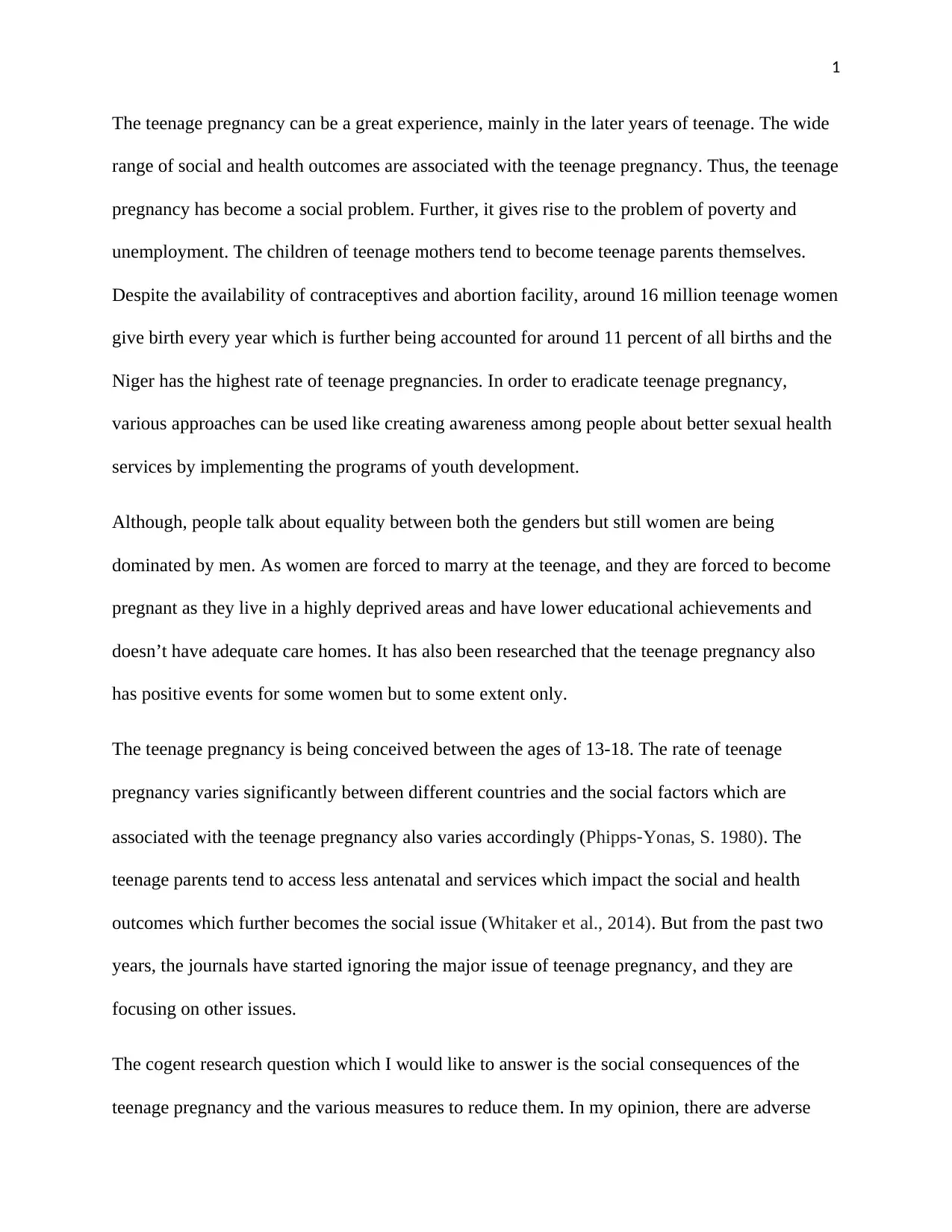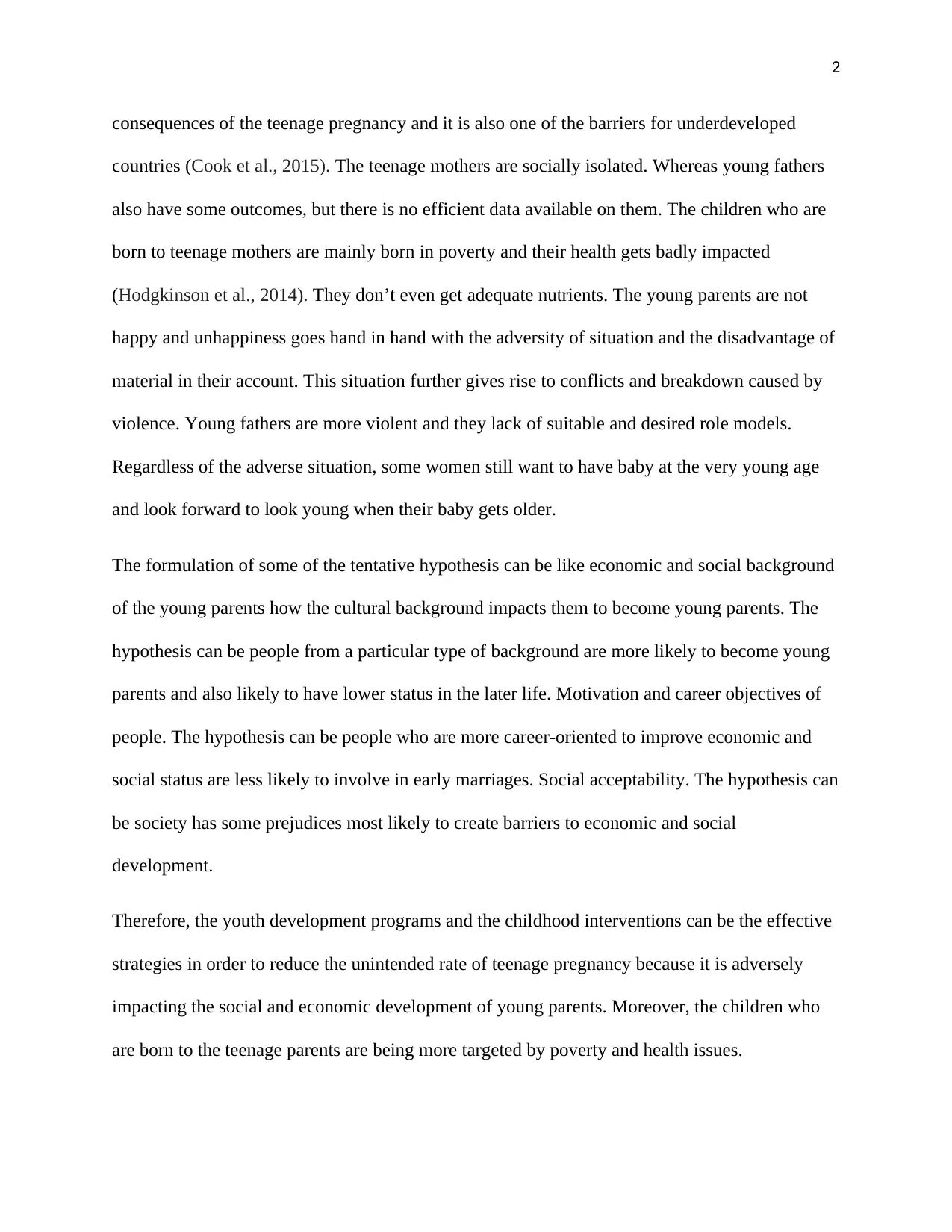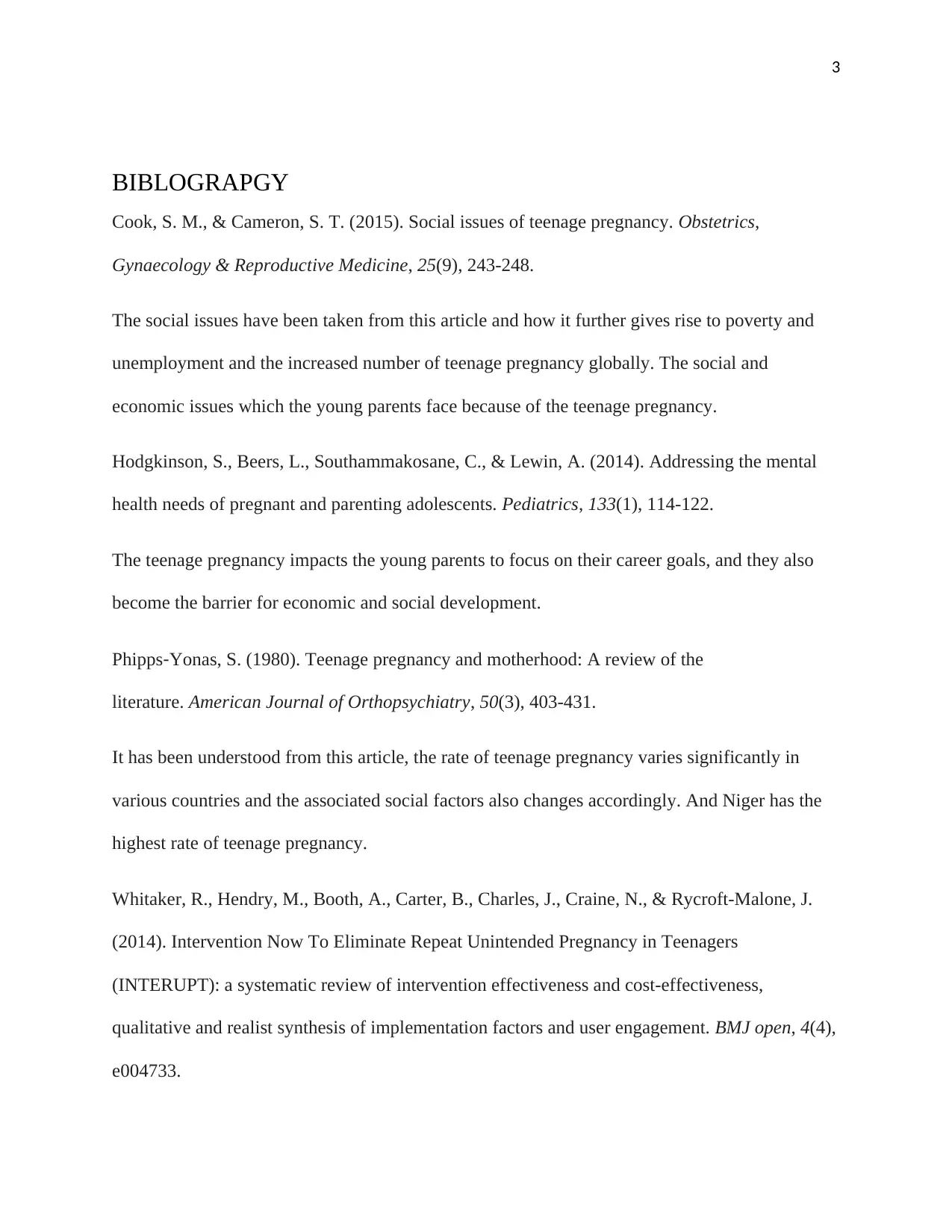Report on the Social Consequences of Teenage Pregnancy and Solutions
VerifiedAdded on 2019/09/23
|5
|1029
|312
Report
AI Summary
This report examines the multifaceted social consequences of teenage pregnancy. It highlights the adverse effects, including poverty, unemployment, and social isolation, while also considering the varying rates and associated factors across different countries. The report emphasizes how teenage pregnancy can lead to limited access to antenatal services and impact both the young parents and their children's health and well-being. It also explores the potential barriers to economic and social development, discusses tentative hypotheses about the influence of background, motivation, and social acceptability, and suggests that youth development programs and childhood interventions can be effective strategies to reduce the unintended rate of teenage pregnancy. The report concludes by referencing key articles that support these findings, underscoring the importance of addressing this critical social issue.

proposal
[Document subtitle]
[Document subtitle]
Paraphrase This Document
Need a fresh take? Get an instant paraphrase of this document with our AI Paraphraser

1
The teenage pregnancy can be a great experience, mainly in the later years of teenage. The wide
range of social and health outcomes are associated with the teenage pregnancy. Thus, the teenage
pregnancy has become a social problem. Further, it gives rise to the problem of poverty and
unemployment. The children of teenage mothers tend to become teenage parents themselves.
Despite the availability of contraceptives and abortion facility, around 16 million teenage women
give birth every year which is further being accounted for around 11 percent of all births and the
Niger has the highest rate of teenage pregnancies. In order to eradicate teenage pregnancy,
various approaches can be used like creating awareness among people about better sexual health
services by implementing the programs of youth development.
Although, people talk about equality between both the genders but still women are being
dominated by men. As women are forced to marry at the teenage, and they are forced to become
pregnant as they live in a highly deprived areas and have lower educational achievements and
doesn’t have adequate care homes. It has also been researched that the teenage pregnancy also
has positive events for some women but to some extent only.
The teenage pregnancy is being conceived between the ages of 13-18. The rate of teenage
pregnancy varies significantly between different countries and the social factors which are
associated with the teenage pregnancy also varies accordingly (Phipps‐Yonas, S. 1980). The
teenage parents tend to access less antenatal and services which impact the social and health
outcomes which further becomes the social issue (Whitaker et al., 2014). But from the past two
years, the journals have started ignoring the major issue of teenage pregnancy, and they are
focusing on other issues.
The cogent research question which I would like to answer is the social consequences of the
teenage pregnancy and the various measures to reduce them. In my opinion, there are adverse
The teenage pregnancy can be a great experience, mainly in the later years of teenage. The wide
range of social and health outcomes are associated with the teenage pregnancy. Thus, the teenage
pregnancy has become a social problem. Further, it gives rise to the problem of poverty and
unemployment. The children of teenage mothers tend to become teenage parents themselves.
Despite the availability of contraceptives and abortion facility, around 16 million teenage women
give birth every year which is further being accounted for around 11 percent of all births and the
Niger has the highest rate of teenage pregnancies. In order to eradicate teenage pregnancy,
various approaches can be used like creating awareness among people about better sexual health
services by implementing the programs of youth development.
Although, people talk about equality between both the genders but still women are being
dominated by men. As women are forced to marry at the teenage, and they are forced to become
pregnant as they live in a highly deprived areas and have lower educational achievements and
doesn’t have adequate care homes. It has also been researched that the teenage pregnancy also
has positive events for some women but to some extent only.
The teenage pregnancy is being conceived between the ages of 13-18. The rate of teenage
pregnancy varies significantly between different countries and the social factors which are
associated with the teenage pregnancy also varies accordingly (Phipps‐Yonas, S. 1980). The
teenage parents tend to access less antenatal and services which impact the social and health
outcomes which further becomes the social issue (Whitaker et al., 2014). But from the past two
years, the journals have started ignoring the major issue of teenage pregnancy, and they are
focusing on other issues.
The cogent research question which I would like to answer is the social consequences of the
teenage pregnancy and the various measures to reduce them. In my opinion, there are adverse

2
consequences of the teenage pregnancy and it is also one of the barriers for underdeveloped
countries (Cook et al., 2015). The teenage mothers are socially isolated. Whereas young fathers
also have some outcomes, but there is no efficient data available on them. The children who are
born to teenage mothers are mainly born in poverty and their health gets badly impacted
(Hodgkinson et al., 2014). They don’t even get adequate nutrients. The young parents are not
happy and unhappiness goes hand in hand with the adversity of situation and the disadvantage of
material in their account. This situation further gives rise to conflicts and breakdown caused by
violence. Young fathers are more violent and they lack of suitable and desired role models.
Regardless of the adverse situation, some women still want to have baby at the very young age
and look forward to look young when their baby gets older.
The formulation of some of the tentative hypothesis can be like economic and social background
of the young parents how the cultural background impacts them to become young parents. The
hypothesis can be people from a particular type of background are more likely to become young
parents and also likely to have lower status in the later life. Motivation and career objectives of
people. The hypothesis can be people who are more career-oriented to improve economic and
social status are less likely to involve in early marriages. Social acceptability. The hypothesis can
be society has some prejudices most likely to create barriers to economic and social
development.
Therefore, the youth development programs and the childhood interventions can be the effective
strategies in order to reduce the unintended rate of teenage pregnancy because it is adversely
impacting the social and economic development of young parents. Moreover, the children who
are born to the teenage parents are being more targeted by poverty and health issues.
consequences of the teenage pregnancy and it is also one of the barriers for underdeveloped
countries (Cook et al., 2015). The teenage mothers are socially isolated. Whereas young fathers
also have some outcomes, but there is no efficient data available on them. The children who are
born to teenage mothers are mainly born in poverty and their health gets badly impacted
(Hodgkinson et al., 2014). They don’t even get adequate nutrients. The young parents are not
happy and unhappiness goes hand in hand with the adversity of situation and the disadvantage of
material in their account. This situation further gives rise to conflicts and breakdown caused by
violence. Young fathers are more violent and they lack of suitable and desired role models.
Regardless of the adverse situation, some women still want to have baby at the very young age
and look forward to look young when their baby gets older.
The formulation of some of the tentative hypothesis can be like economic and social background
of the young parents how the cultural background impacts them to become young parents. The
hypothesis can be people from a particular type of background are more likely to become young
parents and also likely to have lower status in the later life. Motivation and career objectives of
people. The hypothesis can be people who are more career-oriented to improve economic and
social status are less likely to involve in early marriages. Social acceptability. The hypothesis can
be society has some prejudices most likely to create barriers to economic and social
development.
Therefore, the youth development programs and the childhood interventions can be the effective
strategies in order to reduce the unintended rate of teenage pregnancy because it is adversely
impacting the social and economic development of young parents. Moreover, the children who
are born to the teenage parents are being more targeted by poverty and health issues.
⊘ This is a preview!⊘
Do you want full access?
Subscribe today to unlock all pages.

Trusted by 1+ million students worldwide

3
BIBLOGRAPGY
Cook, S. M., & Cameron, S. T. (2015). Social issues of teenage pregnancy. Obstetrics,
Gynaecology & Reproductive Medicine, 25(9), 243-248.
The social issues have been taken from this article and how it further gives rise to poverty and
unemployment and the increased number of teenage pregnancy globally. The social and
economic issues which the young parents face because of the teenage pregnancy.
Hodgkinson, S., Beers, L., Southammakosane, C., & Lewin, A. (2014). Addressing the mental
health needs of pregnant and parenting adolescents. Pediatrics, 133(1), 114-122.
The teenage pregnancy impacts the young parents to focus on their career goals, and they also
become the barrier for economic and social development.
Phipps‐Yonas, S. (1980). Teenage pregnancy and motherhood: A review of the
literature. American Journal of Orthopsychiatry, 50(3), 403-431.
It has been understood from this article, the rate of teenage pregnancy varies significantly in
various countries and the associated social factors also changes accordingly. And Niger has the
highest rate of teenage pregnancy.
Whitaker, R., Hendry, M., Booth, A., Carter, B., Charles, J., Craine, N., & Rycroft-Malone, J.
(2014). Intervention Now To Eliminate Repeat Unintended Pregnancy in Teenagers
(INTERUPT): a systematic review of intervention effectiveness and cost-effectiveness,
qualitative and realist synthesis of implementation factors and user engagement. BMJ open, 4(4),
e004733.
BIBLOGRAPGY
Cook, S. M., & Cameron, S. T. (2015). Social issues of teenage pregnancy. Obstetrics,
Gynaecology & Reproductive Medicine, 25(9), 243-248.
The social issues have been taken from this article and how it further gives rise to poverty and
unemployment and the increased number of teenage pregnancy globally. The social and
economic issues which the young parents face because of the teenage pregnancy.
Hodgkinson, S., Beers, L., Southammakosane, C., & Lewin, A. (2014). Addressing the mental
health needs of pregnant and parenting adolescents. Pediatrics, 133(1), 114-122.
The teenage pregnancy impacts the young parents to focus on their career goals, and they also
become the barrier for economic and social development.
Phipps‐Yonas, S. (1980). Teenage pregnancy and motherhood: A review of the
literature. American Journal of Orthopsychiatry, 50(3), 403-431.
It has been understood from this article, the rate of teenage pregnancy varies significantly in
various countries and the associated social factors also changes accordingly. And Niger has the
highest rate of teenage pregnancy.
Whitaker, R., Hendry, M., Booth, A., Carter, B., Charles, J., Craine, N., & Rycroft-Malone, J.
(2014). Intervention Now To Eliminate Repeat Unintended Pregnancy in Teenagers
(INTERUPT): a systematic review of intervention effectiveness and cost-effectiveness,
qualitative and realist synthesis of implementation factors and user engagement. BMJ open, 4(4),
e004733.
Paraphrase This Document
Need a fresh take? Get an instant paraphrase of this document with our AI Paraphraser

4
It has been understood from this article; it is important to eradicate the issue of teenage
pregnancy as because of this issue equal rights are not given to both the genders for the
development of the country.
It has been understood from this article; it is important to eradicate the issue of teenage
pregnancy as because of this issue equal rights are not given to both the genders for the
development of the country.
1 out of 5
Related Documents
Your All-in-One AI-Powered Toolkit for Academic Success.
+13062052269
info@desklib.com
Available 24*7 on WhatsApp / Email
![[object Object]](/_next/static/media/star-bottom.7253800d.svg)
Unlock your academic potential
Copyright © 2020–2025 A2Z Services. All Rights Reserved. Developed and managed by ZUCOL.





